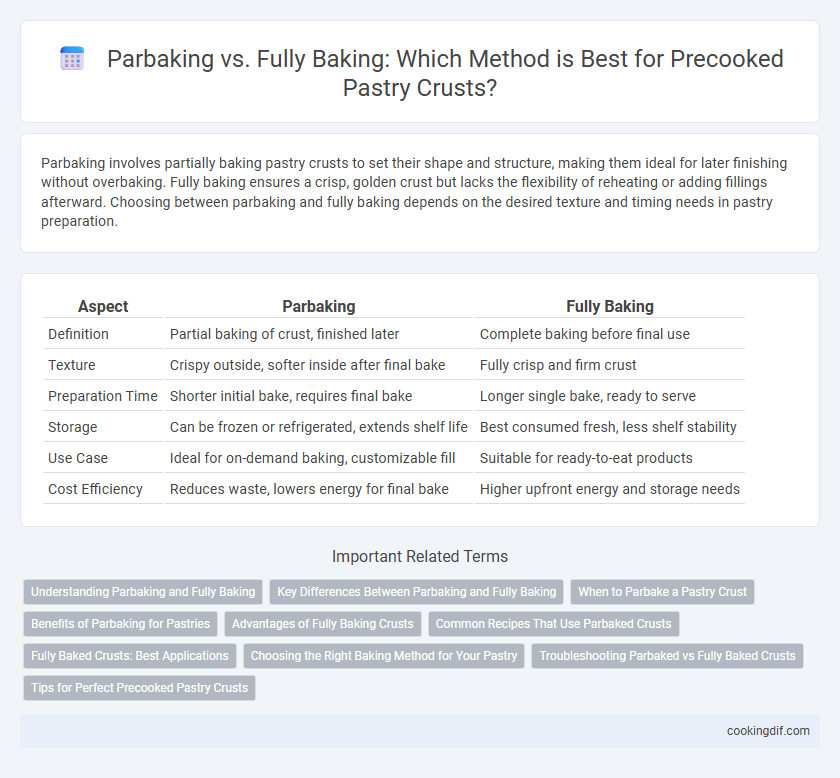Parbaking involves partially baking pastry crusts to set their shape and structure, making them ideal for later finishing without overbaking. Fully baking ensures a crisp, golden crust but lacks the flexibility of reheating or adding fillings afterward. Choosing between parbaking and fully baking depends on the desired texture and timing needs in pastry preparation.
Table of Comparison
| Aspect | Parbaking | Fully Baking |
|---|---|---|
| Definition | Partial baking of crust, finished later | Complete baking before final use |
| Texture | Crispy outside, softer inside after final bake | Fully crisp and firm crust |
| Preparation Time | Shorter initial bake, requires final bake | Longer single bake, ready to serve |
| Storage | Can be frozen or refrigerated, extends shelf life | Best consumed fresh, less shelf stability |
| Use Case | Ideal for on-demand baking, customizable fill | Suitable for ready-to-eat products |
| Cost Efficiency | Reduces waste, lowers energy for final bake | Higher upfront energy and storage needs |
Understanding Parbaking and Fully Baking
Parbaking involves partially baking the pastry crust to set its structure without fully cooking it, allowing for a crisp exterior that can be finished with toppings later. Fully baking the crust means cooking it completely before adding any fillings, ensuring a firm and golden base suitable for immediate serving. Understanding the differences between parbaking and fully baking helps bakers achieve the desired texture and prevent sogginess in precooked crusts.
Key Differences Between Parbaking and Fully Baking
Parbaking partially cooks pastry crusts, typically until the dough firms but remains pale, allowing for a crisp base that finishes baking with fillings. Fully baking involves cooking the crust to complete doneness, producing a golden, fully set shell before adding any toppings or fillings. The key difference lies in texture and timing, with parbaking providing flexibility to prevent sogginess in wet fillings, while fully baked crusts offer immediate consumption and longer shelf life.
When to Parbake a Pastry Crust
Parbaking a pastry crust is essential when using wet or delicate fillings that require longer cooking times, such as custards or fruit pies, to prevent a soggy bottom. It creates a partially cooked shell that sets the dough structure and improves crispness without fully browning or burning. Parbaked crusts are ideal for recipes needing further baking with fillings that might release moisture or cook slower than the crust itself.
Benefits of Parbaking for Pastries
Parbaking precooked pastry crusts preserves a crisp texture by partially baking the dough before adding fillings, which prevents sogginess and ensures even cooking. This technique enhances shelf life and simplifies preparation, allowing quick finishing baking without compromising flakiness or structural integrity. Retailers and home bakers benefit from reduced preparation time while delivering fresh-tasting pastries with consistent quality.
Advantages of Fully Baking Crusts
Fully baking precooked crusts ensures a crisp, golden texture that enhances flavor and structural integrity, preventing sogginess during filling addition. This method guarantees even heat distribution, which improves the crust's durability for both sweet and savory pastries. The thorough baking process also extends shelf life by reducing moisture content, making fully baked crusts ideal for pre-preparation and frozen storage.
Common Recipes That Use Parbaked Crusts
Parbaking preserves the crust's structure while allowing for faster final baking, making it ideal for recipes like quiches, pot pies, and fruit tarts where a crisp, flaky base is essential. This technique prevents sogginess by partially cooking the dough, which is beneficial in custard-filled pies and savory dishes with moist ingredients. Fully baking, in contrast, suits recipes where the crust is served plain or requires no additional filling heat, such as dry cookie or bread crusts.
Fully Baked Crusts: Best Applications
Fully baked crusts offer superior texture and flavor development compared to parbaked options, making them ideal for ready-to-eat pastries and desserts. This method ensures a crisp, golden-brown finish that enhances shelf life and structural integrity in products like quiches, pies, and tarts. Fully baking is preferred in commercial settings where product consistency and immediate consumption quality are critical.
Choosing the Right Baking Method for Your Pastry
Parbaking precooked pastry crusts involves partially baking them to set the structure while keeping the interior raw, ideal for fillings requiring longer cooking times or a fresh-baked texture. Fully baking ensures a crisp, golden crust ready to eat immediately, best suited for recipes with fillings that don't need further baking, like custards or chilled desserts. Selecting between parbaking and fully baking depends on the filling type and desired crust texture, balancing moisture retention and doneness for optimal pastry quality.
Troubleshooting Parbaked vs Fully Baked Crusts
Parbaking crusts provides a partially cooked base ideal for preventing sogginess when adding wet toppings, but may result in a raw or doughy texture if underbaked during final cooking. Fully baking crusts ensures a crisp, golden finish and structural integrity but can cause dryness if overbaked or when reheated. Troubleshooting involves adjusting baking times and temperatures based on filling moisture content and desired crust texture to achieve balance between crispness and tenderness.
Tips for Perfect Precooked Pastry Crusts
Parbaking precooked pastry crusts involves partially baking the crust to set its structure before adding fillings, which prevents sogginess and ensures a crisp texture. Fully baking the crust, on the other hand, requires precise temperature control and timing to avoid over-browning while achieving a golden finish. For optimal results, use a pie shield during baking, chill the dough thoroughly before baking, and bake on a lower rack to promote even heat distribution and a flawless crust.
Parbaking vs Fully baking for precooked crusts Infographic

 cookingdif.com
cookingdif.com